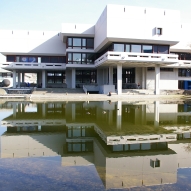 ; Aleksandrova, Krasimira ; Jochem, Carmen ; Jenab, Mazda
; Aleksandrova, Krasimira ; Jochem, Carmen ; Jenab, Mazda  ; Gunter, Marc J. ; Overvad, Kim
; Gunter, Marc J. ; Overvad, Kim  ; Tjønneland, Anne
; Tjønneland, Anne  ; Boutron-Ruault, Marie-Christine
; Boutron-Ruault, Marie-Christine  ; Carbonnel, Franck ; Fournier, Agnès ; Kühn, Tilman ; Kaaks, Rudolf ; Pischon, Tobias
; Carbonnel, Franck ; Fournier, Agnès ; Kühn, Tilman ; Kaaks, Rudolf ; Pischon, Tobias  ; Boeing, Heiner ; Trichopoulou, Antonia ; Bamia, Christina ; La Vecchia, Carlo ; Masala, Giovanna
; Boeing, Heiner ; Trichopoulou, Antonia ; Bamia, Christina ; La Vecchia, Carlo ; Masala, Giovanna  ; Panico, Salvatore ; Fasanelli, Francesca ; Tumino, Rosario ; Grioni, Sara ; Bueno de Mesquita, Bas ; Vermeulen, Roel ; May, Anne M. ; Borch, Kristin B. ; Oyeyemi, Sunday O. ; Ardanaz, Eva ; Rodríguez-Barranco, Miguel ; Dolores Chirlaque López, María ; Felez-Nobrega, Mireia ; Sonestedt, Emily ; Ohlsson, Bodil ; Hemmingsson, Oskar ; Werner, Mårten ; Perez-Cornago, Aurora ; Ferrari, Pietro ; Stepien, Magdalena ; Freisling, Heinz
; Panico, Salvatore ; Fasanelli, Francesca ; Tumino, Rosario ; Grioni, Sara ; Bueno de Mesquita, Bas ; Vermeulen, Roel ; May, Anne M. ; Borch, Kristin B. ; Oyeyemi, Sunday O. ; Ardanaz, Eva ; Rodríguez-Barranco, Miguel ; Dolores Chirlaque López, María ; Felez-Nobrega, Mireia ; Sonestedt, Emily ; Ohlsson, Bodil ; Hemmingsson, Oskar ; Werner, Mårten ; Perez-Cornago, Aurora ; Ferrari, Pietro ; Stepien, Magdalena ; Freisling, Heinz  ; Tsilidis, Konstantinos K. ; Ward, Heather ; Riboli, Elio
; Tsilidis, Konstantinos K. ; Ward, Heather ; Riboli, Elio  ; Weiderpass, Elisabete ; Leitzmann, Michael F.
; Weiderpass, Elisabete ; Leitzmann, Michael F. | Dokumentenart: | Artikel | ||||
|---|---|---|---|---|---|
| Titel eines Journals oder einer Zeitschrift: | Journal of Hepatology | ||||
| Verlag: | Elsevier | ||||
| Ort der Veröffentlichung: | AMSTERDAM | ||||
| Band: | 70 | ||||
| Nummer des Zeitschriftenheftes oder des Kapitels: | 5 | ||||
| Seitenbereich: | S. 885-892 | ||||
| Datum: | 2019 | ||||
| Institutionen: | Medizin > Institut für Epidemiologie und Präventivmedizin | ||||
| Identifikationsnummer: |
| ||||
| Stichwörter / Keywords: | HEPATOCELLULAR-CARCINOMA; VALIDITY; QUESTIONNAIRE; MORTALITY; OBESITY; DISEASE; BURDEN; Hepatobiliary cancer; Hepatocellular carcinoma; Liver cancer; Physical activity | ||||
| Dewey-Dezimal-Klassifikation: | 600 Technik, Medizin, angewandte Wissenschaften > 610 Medizin | ||||
| Status: | Veröffentlicht | ||||
| Begutachtet: | Ja, diese Version wurde begutachtet | ||||
| An der Universität Regensburg entstanden: | Ja | ||||
| Dokumenten-ID: | 48740 |
 Web of Science
Web of ScienceZusammenfassung
Background & Aims: To date, evidence on the association between physical activity and risk of hepatobiliary cancers has been inconclusive. Weexamined this association in the European Prospective Investigation into Cancer and Nutrition cohort (EPIC). Methods: We identified 275 hepatocellular carcinoma (HCC) cases, 93 intrahepatic bile duct cancers (IHBCs), and 164 non-gallbladder extrahepatic bile ...

Zusammenfassung
Background & Aims: To date, evidence on the association between physical activity and risk of hepatobiliary cancers has been inconclusive. Weexamined this association in the European Prospective Investigation into Cancer and Nutrition cohort (EPIC). Methods: We identified 275 hepatocellular carcinoma (HCC) cases, 93 intrahepatic bile duct cancers (IHBCs), and 164 non-gallbladder extrahepatic bile duct cancers (NGBCs) among 467,336 EPIC participants (median follow-up 14.9 years). We estimated cause-specific hazard ratios (HRs) for total physical activity and vigorous physical activity and performed mediation analysis and secondary analyses to assess robustness to confounding (e.g. due to hepatitis virus infection). Results: In the EPIC cohort, the multivariable-adjusted HR of HCC was 0.55 (95% CI 0.38-0.80) comparing active and inactive individuals. Regarding vigorous physical activity, for those reporting >2 hours/week compared to those with no vigorous activity, the HR for HCC was 0.50 (95% CI 0.33-0.76). Estimates were similar in sensitivity analyses for confounding. Total and vigorous physical activity were unrelated to IHBC and NGBC. In mediation analysis, waist circumference explained about 40% and body mass index 30% of the overall association of total physical activity and HCC. Conclusions: These findings suggest an inverse association between physical activity and risk of HCC, which is potentially mediated by obesity. Lay summary: In a pan-European study of 467,336 men and women, we found that physical activity is associated with a reduced risk of developing liver cancers over the next decade. This risk was independent of other liver cancer risk factors, and did not vary by age, gender, smoking status, body weight, and alcohol consumption. (C) 2019 European Association for the Study of the Liver. Published by Elsevier B.V. All rights reserved.
Metadaten zuletzt geändert: 03 Sep 2021 10:02



 Altmetric
Altmetric